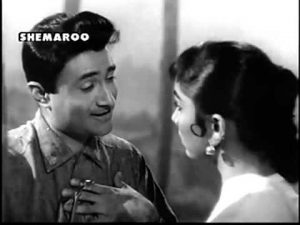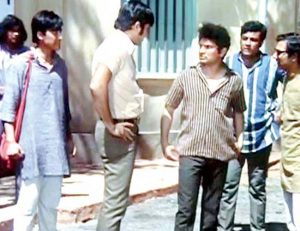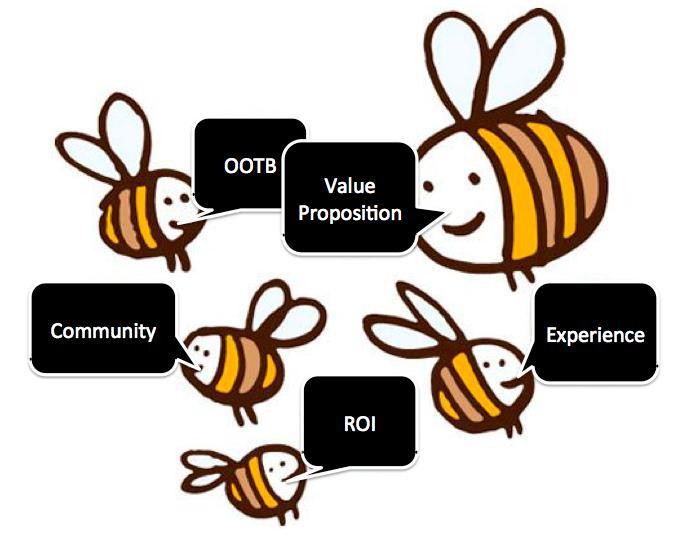Why do we watch movies?
 In the words of Richard Bach – the author of ‘Illusion’ a movie is nothing but an illusion which requires space and time to be experienced. So you pay for the ticket, you settle on in a seat and forget what is going on outside the theatre. People watch movies and dramas for fun, for learning, for taking some lessons, and most importantly they identify with one of the characters in the movie. Same is the case while reading a book; we identify ourselves with one of the characters in the novel.
In the words of Richard Bach – the author of ‘Illusion’ a movie is nothing but an illusion which requires space and time to be experienced. So you pay for the ticket, you settle on in a seat and forget what is going on outside the theatre. People watch movies and dramas for fun, for learning, for taking some lessons, and most importantly they identify with one of the characters in the movie. Same is the case while reading a book; we identify ourselves with one of the characters in the novel.
Moviegoers and readers identify with stories through the characters. The most powerful way to reach an audience is through the characters’ emotions. For only when we connect with the characters on an emotional level, the communication becomes deep and meaningful. Well-written scenes that include characters’ emotions allow the audience to absorbedly take part in the story and bond with the characters. In our real life, we meet and interrelate daily with other people. Unlike in stories, many of these interactions are fairly apparent. While some audience rather enjoy a more distanced, intellectual challenge, many others want to engage with characters in books and movies on an emotional level. Through the character’s emotions, experience, learning etc the audience live their lives. Writing, plotting, editing, etc is not a joke. It requires great talent to script a story, choose the right actors to emote those characters, a great writer to write dialogues, a great editor to edit scenes to reinforce significance of emotion in creating a persuasive story.
A movie requires developing the character’s emotional development as it leads to their ultimate transformation at the overall story level. It needs to portray the character’s more transitory emotional reactions at the scene level. Often writers get stuck by staying in the character’s head and “telling” what the character thinks. An emotion, on the other hand, has a strong physical component and is primarily felt in the body. The writer is able to “show” emotions through how the character relates or reacts to conflict. Emotions always tell the truth. Most of us in real life are capable of handling ourselves when things go well or working in our favour. But, when we are thrown in some sort of disaster, conflict, roadblock we find out who we truly are. This same principle applies in stories. Moviegoers and readers alike want to participate in dramatic stories to learn how characters respond emotionally when things turn disorganized, challenging, and stressful, when all is lost.
 Storytelling involves more than lining up the action pieces, arranging them in a logical order and then drawing conclusions. Yes, dramatic actions pull moviegoers to the edge of their seats. Emotions such as conflict, tension, suspense and curiosity hook moviegoers. Yet, no matter how exciting the action, the character’s emotional reactions and emotional development provide an appeal. Any presentation with a strong human element increases the chances of audience identification. Why ‘Gone with the wind’ is still a great movie? The reason being – the Costumes for one, Vivien and Clark Gables performance, the way the movie shows hard times and a woman of great demeanour – the protagonist isn’t afraid to get her hands dirty to help herself and her family survive. The courage it takes to survive. The great romance between Scarlett and Rett Butler and it shows how a woman draws her strength through her feminity. The romantic pairing of the fabulous Clark Gable with Vivien Leigh is absolutely unparalleled in cinema history!
Storytelling involves more than lining up the action pieces, arranging them in a logical order and then drawing conclusions. Yes, dramatic actions pull moviegoers to the edge of their seats. Emotions such as conflict, tension, suspense and curiosity hook moviegoers. Yet, no matter how exciting the action, the character’s emotional reactions and emotional development provide an appeal. Any presentation with a strong human element increases the chances of audience identification. Why ‘Gone with the wind’ is still a great movie? The reason being – the Costumes for one, Vivien and Clark Gables performance, the way the movie shows hard times and a woman of great demeanour – the protagonist isn’t afraid to get her hands dirty to help herself and her family survive. The courage it takes to survive. The great romance between Scarlett and Rett Butler and it shows how a woman draws her strength through her feminity. The romantic pairing of the fabulous Clark Gable with Vivien Leigh is absolutely unparalleled in cinema history!
A Bollywood movie like ‘Hum Dono’ 1961 which Set in the period of World War 2 on the backdrop of India-Burma war, Hum Dono is not an out-and-out war film as might be the notion, but more of an emotional drama. The central plot had classic conflicts ranging from the rich-girl-poor-boy formula to the identity swapping in the double-role premise. However, while these may appear as clichés today; in the scheme of things in1961 these were still one of those innovative plot-points which went on to be trendsetter and subsequently stereotypes in Hindi cinema. Including myself I know at least another hundred people who love watching this trendsetting movie for reasons such as Dev Anand’s emotional acting, the storyline, songs, superb dialogues so on and forth.
In a compelling story line, the characters grow and change step-by-step because of the dramatic action. This growth is not meant merely on a physical level. Often, in their enthusiasm of showing off high-tech special effects, moviemakers and writers forget the power of character emotional development. The challenges a character faces must effect the character emotionally, and the deeper the better. An effective way to keep track of these strongly growing steps is with the use of a Scene Tracker. I would like to make reference of a great movie such as ‘zinadagi na milegi dobara’ directed by Zoya Akhtar. We can easily identify with one of the characters of the movie. That’s the power of powerful storytelling.
Movies often rely on star power alone without taking the time to develop the characters in the story. Even so, the audience may feel an emotional attachment to the star. Ultimately, however, unless they emotionally identify with the main character as a character, the audience will ultimately detach from the film.
 Ultimately, the reason why we would want to live sensationally through the lives of others, be it a fictional character or a real person, is because we find others’ lives more interesting or exciting than ours. We find their roles interesting because we see the characters on screen achieving something that we want for ourselves and our life, but have yet to fully achieve that yet.
Ultimately, the reason why we would want to live sensationally through the lives of others, be it a fictional character or a real person, is because we find others’ lives more interesting or exciting than ours. We find their roles interesting because we see the characters on screen achieving something that we want for ourselves and our life, but have yet to fully achieve that yet.
Men and women grow up expecting to be the hero of their own story. We are all characters in other people’s stories, and so other people are characters in our own. We all see the world through our lens in the end. We have a world where girls grow up identifying closely with male heroes and putting themselves into the heroes’ shoes, understanding and relating to them. Do you think boys grow up identifying with women characters at all? Yes, even they do.
Look at 1978’s Superman, what I can definitely say is that that movie has left a huge literary impact, even after all these many years. It still has influence around the world and has given studios the runway for future superhero movies to take place. I mean just look at the entire slate of movies lined up until 2020. For the most part, we have been given superhero movies with very similar story-lines, some just showing a guy and a group of people, gearing up for the final climatic fight against the BOSS level.
Our lives are changing, we are all moving at a faster pace. Who knows, maybe in 50 years time we may have flying cars and Smartphone in our brains. How would superhero movies work in the future? Would we see Spider-Man swinging from flying car to flying car? Yes, maybe. Will we witness Captain America being awakened from a 60 year sleep to find him in our high flying future society? We may. As human we are imaginative, emotional, quirky, inquisitive, we love, we fear, we feel jealous, we want to shoot somebody, we want to experience romance and what not….. What we cannot do in a real life we sit and enjoy doing all that on screen in a reel life. Whether watching a retro classic such as ‘Tere mere sapane’ or turning out for the opening weekend of Man of Steel, there’s something special about going to the movies.
At home, distractions such as nagging kids or parents, ringing phones, texts on mobile, ringing phones, cleaning, and many other chores do not allow us to enjoy a movie. The theatre gives us an excuse to switch off for a couple hours and surrender to a completely immersive experience. It’s through this uninterrupted story telling that movies deliver their full emotional and creative intent.
 As humans we enter the darkened theatre seeking three things: one, to expand our emotional bandwidth – in sense to feel sensations that we rarely experience in our normal lives; to reconnect with our higher selves. Two, to be reminded of what humans are capable of, in terms of both good and evil, and to alter course if we’re steering more towards the latter than the former. And, three, to be reminded we are not alone; through the collective reaction of others in the audience we realise that we are not the only ones wrestling with life’s challenges – there are many other like us. And, therefore we watch movies.
As humans we enter the darkened theatre seeking three things: one, to expand our emotional bandwidth – in sense to feel sensations that we rarely experience in our normal lives; to reconnect with our higher selves. Two, to be reminded of what humans are capable of, in terms of both good and evil, and to alter course if we’re steering more towards the latter than the former. And, three, to be reminded we are not alone; through the collective reaction of others in the audience we realise that we are not the only ones wrestling with life’s challenges – there are many other like us. And, therefore we watch movies.













































